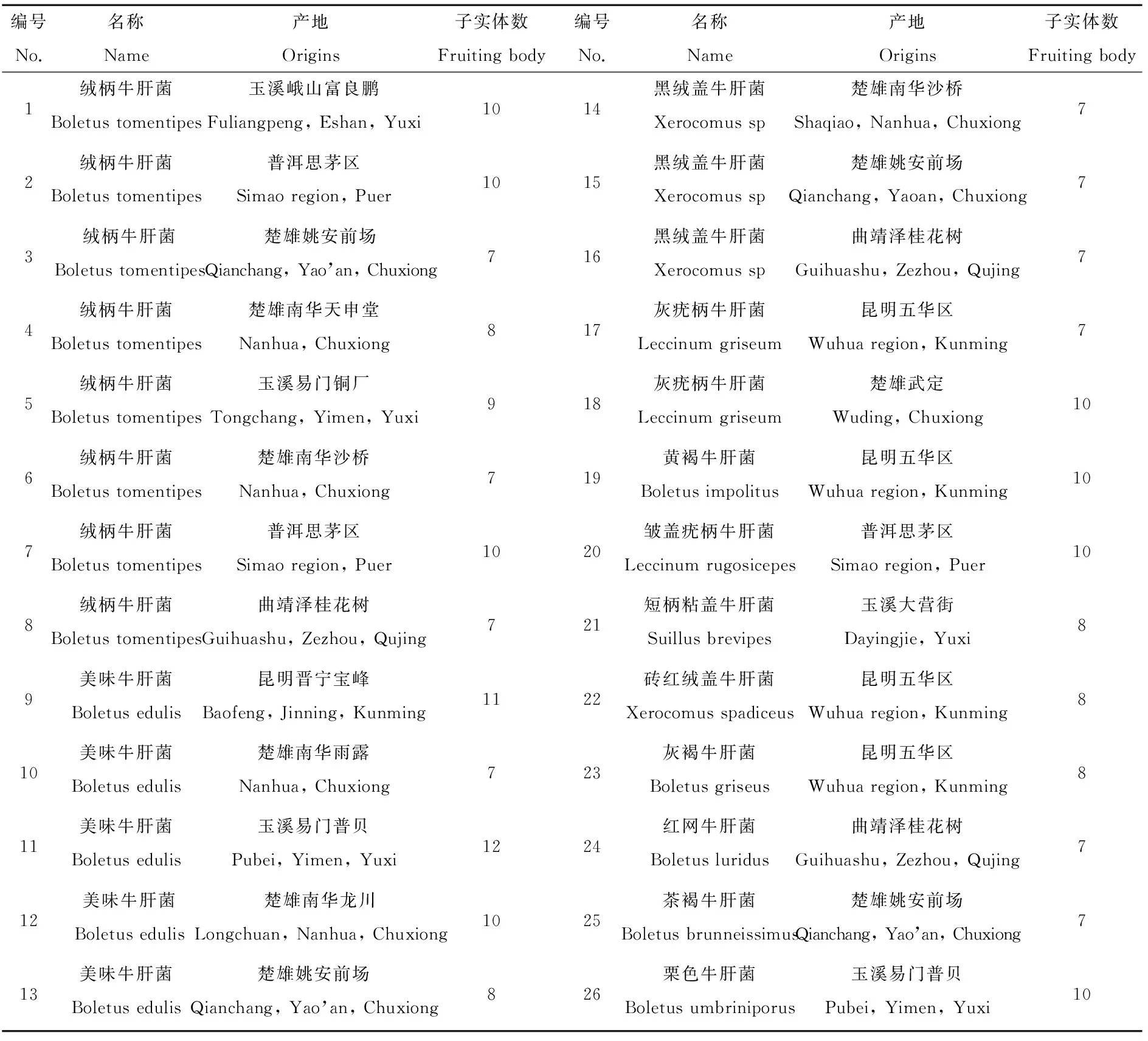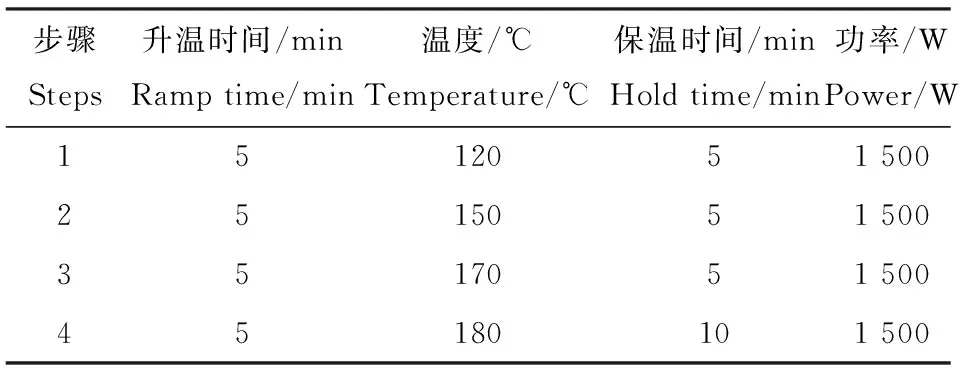云南野生牛肝菌中砷元素含量測定及食用安全評價
楊天偉,張霽,劉鴻高,王元忠,*
1. 云南省農業科學院藥用植物研究所,昆明 650200 2. 云南農業大學農學與生物技術學院,昆明 650201 3. 云南省省級中藥原料質量監測技術服務中心,昆明 65200
?
云南野生牛肝菌中砷元素含量測定及食用安全評價
楊天偉1,2,張霽1,3,劉鴻高2,王元忠1,3,*
1. 云南省農業科學院藥用植物研究所,昆明 650200 2. 云南農業大學農學與生物技術學院,昆明 650201 3. 云南省省級中藥原料質量監測技術服務中心,昆明 65200
通過ICP-AES法測定了26個云南野生牛肝菌居群中As元素含量,分析不同地區、種類牛肝菌對As的富集特征;采用單項污染指數法評價云南野生牛肝菌的As污染水平;根據FAO/WHO規定的每周As允許攝入量評估野生牛肝菌的As暴露風險。結果顯示:(1)不同產地、種類牛肝菌中As含量差異明顯,其中菌蓋的As平均含量在(0.18±0.31)~(13.33±2.21) mg·kg-1dw之間,菌柄的As平均含量在(0.06±0.10)~(17.09±5.8) mg·kg-1dw之間;表明牛肝菌對As元素的富集程度與牛肝菌種類、生長環境等因素有關;(2)不同種類牛肝菌菌蓋、菌柄的As污染指數分別在0.35~26.66及0.12~34.20之間,且多數牛肝菌的As污染指數大于1,表明多數牛肝菌的As含量超過GB2762-2012規定的限量標準,處于重污染水平;(3)若成年人每周食用500 g新鮮牛肝菌,則通過牛肝菌攝入的As均低于FAO/WHO規定的PTWI標準(As≤0.9 mg),未達到As暴露水平;然而日常生活中人們除了通過野生牛肝菌攝入As元素外還會通過其他食物(大米、肉類等)、飲水、呼吸等途徑攝入As元素,因此,為了防止As暴露危害人體健康,不宜大量或長期食用野生牛肝菌。
砷;野生牛肝菌;健康風險;單項污染指數;云南
Received 16 November 2015 accepted 2 January 2016
砷(As)及其化合物是公認的有毒致癌物質,其中無機砷的毒性、致癌、致突變性大于有機砷[1-3]。As及其化合物可通過食物、水、呼吸和皮膚接觸進入人體,蓄積于人體的組織或器官,當As蓄積量超過一定限量時,會影響人體健康和生命安全[4-7]。食物和飲水是人體攝入As的重要途徑,尤其通過食物攝入的As占人體內總As的比例較高,因此食物中的As成為非職業性As暴露的主要原因[8-9]。
食用菌營養豐富,味道鮮美被譽為21世紀綠色優質的健康食品[10-11];隨著人民生活水平提高,食用菌成為餐桌上接人待客的佳肴[12]。云南野生牛肝菌是世界性著名食用菌,它不僅是煲湯、火鍋的重要食材,也是罐頭、糕點的美味配料,目前已出口到英國、德國、意大利、日本等40多個國家。然而研究顯示,野生食用菌對重金屬有很強的富集能力,因此食用菌中有毒重金屬超標成為消費者重金屬暴露的潛在風險[13-17]。
據文獻報道,食用菌對As元素有很強的富集能力;1998年丹麥的學者研究了As污染與未污染地區紫蠟蘑(Laccaria amethystina)對As的富集程度,發現污染地區紫蠟蘑的As含量能達到1 420 mg·kg-1dry weight (dw)[18]。Zhang等[19]測定了云南不同地區野生蠟蘑屬真菌的As含量,發現紅蠟蘑(Laccaria laccata),紅榛色蠟蘑(Laccaria vinaceoave)和紫晶蠟蘑(Laccaria amethysthea)的菌蓋中As含量均有超標現象,食用有潛在的健康風險。Liu等[20]采用ICP-MS測定了采自云南不同地區的8種野生食用菌的As含量,結果顯示美味牛肝菌(Boletus edulis)、大紅菇(Russula alutacea)、松口蘑(Tricholoma matsutake)等多種食用菌的As含量超標。因此分析野生食用菌中As元素含量,了解野生食用菌對As的富集特征及進行健康風險評估有重要意義。
本文采集了10多種云南常見的野生牛肝菌樣品,采用ICP-AES法測定了牛肝菌中As元素含量,分析不同種類牛肝菌對As的富集規律,根據GB2762-2012規定的食用菌污染物限量標準分析野生牛肝菌的As污染水平;按聯合國糧農組織和世界衛生組織(FAO/WHO)規定的每周As允許攝入量標準進行食用安全評估,為野生牛肝菌的食用安全評價提供數據依據。
1 材料與方法 (Materials and methods)
1.1 實驗材料
野生牛肝菌采集后用塑料刀刮去泥土、砂石、雜草、枯枝等異物,依次用自來水和超純水清洗,于恒溫箱中50 ℃烘干至恒重,粉碎過80目塑料篩盤,保存于聚乙烯自封袋中,備用。牛肝菌種類及采集地點見表1。
1.2 儀器及試劑
儀器:ICPE-9000電感耦合等離子體原子發射光譜儀(日本島津公司);MARS6型微波消解儀(美國CEM公司)。
試劑:65%硝酸(優級純),30%過氧化氫(分析純),As元素標準溶液(濟南眾標科技有限公司);生物成分分析標準物質選用茶葉(GBW07605)和菠菜(GBW10015)(地礦部物化探研究所),超純水。
1.3 消解牛肝菌樣品
精密稱取0.3000 g牛肝菌樣品,放入消解罐中,加入6 mL硝酸,3 mL 30%雙氧水和1 mL超純水,加蓋密封,按表2的微波消解步驟及條件將牛肝菌樣品消解完全,冷卻后取出消解罐;將消解液完全轉移到25 mL具塞比色管,用超純水定容到25 mL刻度線,搖勻,澄清后待測。用上述方法消解茶葉、菠菜標準物質及制備空白樣品。

表1 牛肝菌樣品信息

表2 微波消解條件
1.4 建立標準曲線
取1 mL As元素標準溶液(1 000 μg·mL-1)于100 mL容量瓶中,用10% HNO3定容到刻度線,搖勻,配成10 μg·mL-1的As標準儲備液。分別取0.00、0.20、0.50、1.00、5.00、10.00 mL As元素標準儲備液(10 μg·mL-1)于100 mL容量瓶中,用10% HNO3定容,配制成0.0、0.02、0.05、0.1、0.5、1.0 μg·mL-1的標準溶液用于建立As元素的標準曲線。
1.5 As含量測定
ICP-AES的工作參數設定為:等離子體氣流速為10 L·min-1,載氣流速為0.7 L·min-1,輔助氣流速為0.6 L·min-1,高頻頻率為27.12 MHz,輸出功率為1.2 kW。As元素的測定波長選擇189.042 nm;按從低到高的濃度梯度測定1.4節配制的As元素標準溶液,建立標準曲線;然后測定空白試樣,標準物質(茶葉、菠菜)和牛肝菌樣品的As含量。
1.6 實驗數據處理
牛肝菌的As元素含量進行方差分析,比較不同種類牛肝菌對As的富集情況;根據FAO/WHO規定的每周As允許攝入量標準和我國GB2762-2012規定的食用菌As限量標準,評估野生牛肝菌食用安全性及As暴露風險。以單項污染指數法分析As的污染程度,其計算公式為:
PAs=CAs/SAs
其中PAs為牛肝菌的As污染指數,CAs為牛肝菌樣品的As含量,SAs為食用菌及其制品中As限量標準。
2 結果與討論(Results and discussion)
2.1 方法學考察
As元素的標準曲線方程為:y=0.0935x+0.2117相關系數r2=0.9994。平行3次測定茶葉標準物質(GBW07605)中As平均含量為(0.274±0.06) mg·kg-1與標準值(0.28±0.04) mg·kg-1相近,菠菜標準物質(GBW10015)的As含量測定值為(0.21±0.02) mg·kg-1與標準值(0.23±0.03) mg·kg-1比較接近;牛肝菌樣品的As加標回收率為92.8%,表明該方法準確、可靠。

表3 牛肝菌的As含量及菌蓋、菌柄的含量比
注:ND表示未檢出;Q(c/s)指菌蓋與菌柄的As含量比。
Note: ND is not detected; Q(c/s)is the As concentration quotient of cap to stipe.
2.2 牛肝菌As含量分析
牛肝菌樣品的As含量測定結果見表3。由表3可知不同種類、產地牛肝菌菌蓋、菌柄的As含量存在明顯差異,其中采自玉溪易門普貝的栗色牛肝菌菌蓋、菌柄的As平均含量最低分別為:(0.18±0.31) mg·kg-1dw和(0.06±0.10) mg·kg-1dw,而采自昆明五華區的灰疣柄牛肝菌菌蓋、菌柄的As含量最高分別為(13.33±2.21) mg·kg-1dw和(17.09±5.8) mg·kg-1dw,這2種牛肝菌菌蓋或菌柄的As含量均具有顯著性差異(P<0.05)。采自普洱思茅區的絨柄牛肝菌菌蓋、菌柄的As含量僅次于昆明五華區的灰疣柄牛肝菌,分別達到(10.81±3.03) mg·kg-1dw和(13.38±2.75) mg·kg-1dw;2種牛肝菌菌蓋的As含量存在差異但未到達顯著水平,而菌柄的As含量差異達到顯著水平(P<0.05);不同種類、產地牛肝菌的砷含量差異可能與牛肝菌種類及不同地區土壤、氣候等環境差異有關。
由同一居群不同牛肝菌子實體的As含量范圍可知,同一種牛肝菌不同子實體間的As含量有明顯差異。比如采自普洱思茅區的10個絨柄牛肝菌子實體(2號樣品)菌蓋的As含量在0.04~10.34 mg·kg-1dw之間,菌柄的As含量在0.37~6.35 mg·kg-1dw之間;采自昆明晉寧寶峰的11個美味牛肝菌子實體(9號樣品)菌蓋、菌柄的As含量分別在0.05~1.79 mg·kg-1dw和未檢出~1.16 mg·kg-1dw之間,表明牛肝菌對As元素的富集程度還與牛肝菌的生長階段、子實體大小等自身因素有關。
本實驗所測定的牛肝菌樣品中As含量遠低于文獻報道的蠟蘑屬(Laccaria)真菌及紫星裂盤菌(Sarcosphaera coronaria)的As最高含量值[19,21]。Zhang等[22]測定了云南及周邊地區48種野生食藥用蘑菇中As元素含量,發現不同種類野生菌中As含量有明顯差異,其中黃硬皮馬勃(Scleroderma citrinum)的As含量最高為1.7 mg·kg-1dw,香菇(Lentinus edodes)中含量最低,僅為0.019 mg·kg-1dw,多數牛肝菌樣品的As含量低于0.8 mg·kg-1dw。黃晨陽等[23]測定了12種野生食用菌的重金屬含量,發現華麗牛肝菌(Boletus magnificus)的As含量最低為0.55 mg·kg-1dw,而松茸(Tricholoma matsutake)的As含量最高,達到5.2 mg·kg-1dw。Ayaz等[24]測定了土耳其地區野生食用菌中多種礦質元素含量,發現紅蠟蘑中As含量最高,而美味牛肝菌、雞油菌(Cantharellus cibarius)等樣品中未未檢出。
2.3 牛肝菌不同部位As含量差異分析
研究報道,元素在食用菌的不同部位中分布不均勻,一般呈現菌蓋>菌柄的規律,但也因元素種類及食用菌物種不同而存在差異[25]。牛肝菌菌蓋與菌柄的As含量比(QC/S)能反映出菌蓋、菌柄對As元素的富集能力差異。由表3可知,不同產地、種類牛肝菌菌蓋、菌柄的As含量比(QC/S)介于0.19~2.99之間,其中采自曲靖澤桂花樹的黑絨蓋牛肝菌的QC/S值最小,菌蓋的As含量遠低于菌柄;采自玉溪易門普貝的栗色牛肝菌菌蓋的As含量是菌柄的2.99倍(QC/S=2.99);而樣品4和樣品12的QC/S分別為1.04和0.91,表明菌蓋、菌柄的As含量較接近。綜上可知,本研究中牛肝菌不同部位對As的富集程度沒有規律可循,存在菌蓋含量高于菌柄或菌柄的含量高于菌蓋的情況,也存在菌蓋與菌柄As含量比較接近的現象,這可能與牛肝菌對As元素的富集特性有關。

表4 不同種類牛肝菌的As污染指數及As攝入量估計
注:“*”指食用500 g新鮮牛肝菌攝入的As。
Note:“*”is As intake estimates when consumption of 500 g fresh bolete.
2.4 牛肝菌食用安全評估
2.4.1 As污染指數
根據GB2762-2012規定的食用菌及其制品中As限量標準(As≤0.5 mg·kg-1)及牛肝菌樣品的As含量計算牛肝菌的As的污染指數;一般認為污染指數大于1,則樣品處于重污染水平。由表4可知,牛肝菌菌蓋、菌柄的As污染指數在0.35~26.66及0.12~34.20之間;80%以上牛肝菌的As污染指數大于1,表明多數牛肝菌處于重污染水平,其中采自昆明五華區的灰疣柄牛肝菌菌蓋、菌柄的As含量是分別是GB2762-2012規定的食用菌As限量標準的26.66倍和34.20倍,As超標嚴重。
2.4.2 每周允許攝入量(PTWI)
FAO/WHO規定每周As允許攝入量應≤0.015 mg·kg-1body weight (bw)[26]。以成年人平均體重60 kg計算,則每人一周允許攝入的As為:60 kg×0.015 mg·kg-1=0.9 mg。假設成年人每周食用500 g新鮮牛肝菌,則通過牛肝菌攝入的As為:500×10%×牛肝菌的As含量(其中10%為牛肝菌干重約占其總質量的比例)。
由表4可知成年人每周食用500 g新鮮牛肝菌菌蓋或菌柄,攝入的As分別在0.01~0.67 mg和0.003~0.85 mg之間。與PTWI標準(As≤0.9 mg)相比,通過食用500 g新鮮牛肝菌攝入的As均低于PTWI標準;然而食用500 g采自昆明五華區的灰疣柄牛肝菌攝入的As與PTWI標準十分接近,同時日常生活中人們還通過其他食物攝入As元素,因此,為了防止As暴露危害人體健康,不宜大量或長期食用灰疣柄牛肝菌。
采用ICP-AES法測定了云南不同地區、種類牛肝菌中As元素含量,結果顯示不同產地、種類牛肝菌中As含量差異明顯,菌蓋、菌柄的As平均含量分別在:(0.18±0.31)~(13.33±2.21) mg·kg-1dw和(0.06±0.10)~(17.09±5.8) mg·kg-1dw之間;同一居群不同牛肝菌子實體之間的As含量也存在差異,表明牛肝菌對As元素的富集程度不僅與牛肝菌種類、生長環境等因素有關,還與牛肝菌的生長階段、子實體大小等自身因素有關。
根據GB 2762-2012規定的食用菌As限量標準計算牛肝菌的As污染指數,結果顯示多數牛肝菌的As污染指數大于1,其中采自昆明五華區的灰疣柄牛肝菌菌蓋、菌柄的As污染指數分別為26.66和34.20,該牛肝菌As超標嚴重,處于重污染水平。若成年人每周食用500 g新鮮牛肝菌,則通過牛肝菌攝入的As均低于FAO/WHO規定的PTWI標準(As≤0.9 mg);因此,每周食用500 g新鮮牛肝菌理論上未達到As暴露水平。然而日常生活中人們除了通過食用野生牛肝菌攝入As元素外還會通過其他食物(大米、肉類等)、飲水、呼吸等途徑攝入As元素[8-9],因此,為了防止As暴露危害人體健康,不宜大量或長期食用野生牛肝菌。
[1] Kitchin K T. Recent advances in arsenic carcinogenesis:Modes of action, animal model systems, and methylated arsenic metabolites [J]. Toxicology and Applied Pharmacology, 2001, 172(3): 249-261
[2] Qu W, Waalkes M P. Metallothionein blocks oxidative DNA damage induced by acute inorganic arsenic exposure [J]. Toxicology and Applied Pharmacology, 2015, 282(3): 267-274
[3] 莫小榮, 吳烈善, 鄧書庭, 等. 某冶煉廠拆遷場地土壤重金屬污染健康風險評價[J]. 生態毒理學報, 2015, 10(4): 235-243
Mo X R, Wu L S, Deng S T, et al. Health risk assessment of heavy metal in soil of demolished smelting site [J]. Asian Journal of Ecotoxicology, 2015, 10(4): 235-243 (in Chinese)
[4] Goldberg S, Manning B A. Speciation of arsenic (III)/arsenic (V) and selenium (IV)/selenium (VI) using coupled ion chromatography-hydride generation atomic absorption spectrometry [J]. Methods in Biogeochemistry of Wetlands, 2013(methodsinbiogeo): 801-814
[5] Jomova K, Jenisova Z, Feszterova M, et al. Arsenic:Toxicity, oxidative stress and human disease [J]. Journal of Applied Toxicology, 2011, 31(2): 95-107
[6] Bundschuh J, Nath B, Bhattacharya P, et al. Arsenic in the human food chain:The Latin American perspective [J]. Science of the Total Environment, 2012, 429: 92-106
[7] Person R J, Ngalame N N O, Makia N L, et al. Chronic inorganic arsenic exposure in vitro induces a cancer cell phenotype in human peripheral lung epithelial cells [J]. Toxicology and Applied Pharmacology, 2015, 286(1): 36-43
[8] Jackson B P, Punshon T. Recent advances in the measurement of arsenic, cadmium, and mercury in rice and other foods [J]. Current Environmental Health Reports, 2015, 2(1): 15-24
[9] 肖細元, 陳同斌, 廖曉勇, 等. 我國主要蔬菜和糧油作物的砷含量與砷富集能力比較[J]. 環境科學學報, 2009, 29(2): 291-296
Xiao X Y, Chen T B, Liao X Y, et al. Comparison of concentrations and bioconcentration factors of arsenic in vegetables, grain and oil crops in China [J]. Acta Scientiae Circumstantiae, 2009, 29(2): 291-296 (in Chinese)
[10] Wang X M, Zhang J, Wu L H, et al. A mini-review of chemical composition and nutritional value of edible wild-grown mushroom from China [J]. Food Chemistry, 2014, 151: 279-285
[12] 溫秋林, 陸娟. 北京市消費者食用菌消費行為與消費需求分析[J]. 北方園藝, 2015(14): 197-200
Wen Q L, Lu J. Analysis on consumer behavior and demand of mushroom based on consumers in Beijing [J]. Northern Horticulture, 2015(14): 197-200 (in Chinese)
[13] Cocchi L, Vescovi L, Petrini L E, et al. Heavy metals in edible mushrooms in Italy [J]. Food Chemistry, 2006, 98(2): 277-284
[14] Zhu F, Qu L, Fan W, et al. Assessment of heavy metals in some wild edible mushrooms collected from Yunnan Province, China [J]. Environmental Monitoring and Assessment, 2011, 179(1-4): 191-199
[15] Fang Y, Sun X, Yang W, et al. Concentrations and health risks of lead, cadmium, arsenic, and mercury in rice and edible mushrooms in China [J]. Food Chemistry, 2014, 147: 147-151
[16] Falandysz J, Zhang J, Wang Y Z, et al. Evaluation of the mercury contamination in mushrooms of genus Leccinum from two different regions of the world: Accumulation, distribution and probable dietary intake [J]. Science of The Total Environment, 2015, 537: 470-478
[17] Wiejak A, Wang Y, Zhang J, et al. Bioconcentration potential and contamination with mercury of pantropical mushroom Macrocybe gigantea [J]. Journal of Environmental Science and Health, Part B, 2014, 49(11): 811-814
[18] Larsen E H, Hansen M, G?ssler W. Speciation and health risk considerations of arsenic in the edible mushroom Laccaria amethystina collected from contaminated and uncontaminated locations [J]. Applied Organometallic Chemistry, 1998, 12(4): 285-291
[19] Zhang J, Li T, Yang Y L, et al. Arsenic concentrations and associated health risks in laccaria mushrooms from Yunnan (SW China) [J]. Biological Trace Element Research, 2015, 164(2): 261-266
[20] Liu B, Huang Q, Cai H, et al. Study of heavy metal concentrations in wild edible mushrooms in Yunnan Province, China [J]. Food Chemistry, 2015, 188: 294-300
[21] Stijve T, Vellinga E C, Herrmann A. Arsenic accumulation in some higher fungi [J]. Persoonia-Molecular Phylogeny and Evolution of Fungi, 1990, 14(2): 161-166
[22] Zhang J, Liu H, Li S J, et al. Arsenic inedible and medicinal mushrooms from Southwest China [J]. International Journal of Medicinal Mushrooms, 2015, 17(6): 601-605
[23] 黃晨陽, 陳強, 趙永昌, 等. 云南省主要野生食用菌中重金屬調查[J]. 中國農業科學, 2010, 43(6): 1198-1203
Huang C Y, Chen Q, Zhao Y C, et al. Investigation on heavy metals of main wild edible mushrooms in Yunnan Province [J]. Scientia Agricultura Sinica, 2010, 43(6): 1198-1203 (in Chinese)
[24] Ayaz F A, Torun H, Colak A, et al. Macro- and microelement contents of fruiting bodies of wild-edible mushrooms growing in the East Black Sea region of Turkey [J]. Food and Nutrition Sciences, 2011, 2(2): 53
[25] Falandysz J, Kojta A K, Jarzyńska G, et al. Mercury in bay bolete (Xerocomus badius): Bioconcentration by fungus and assessment of element intake by humans eating fruiting bodies [J]. Food Additives & Contaminants: Part A, 2012, 29(6): 951-961
[26] JECFA. Joint FAO/WHO Expert committee on food additives. Summary and conclusions [C]. Proceedings of the Seventy-Second Meeting, Rome, Food and Agriculture Organization of the United Nations World Health Organization, 16-25 February 2010
◆
Determination and Food Safety Assessment of Arsenic in Wild-grown Bolete Mushrooms from Yunnan Province
Yang Tianwei1,2, Zhang Ji1,3, Liu Honggao2, Wang Yuanzhong1,3,*
1. Institute of Medicinal Plants, Yunnan Academy of Agricultural Sciences, Kunming 650200, China 2. College of Agronomy and Biotechnology, Yunnan Agricultural University, Kunming 650201, China 3. Yunnan Technical Center for Quality of Chinese Materia Medica, Kunming 650200, China
In this study the arsenic (As) contents in 26 wild-grown bolete populations from Yunnan Province were determined by ICP-AES. The accumulation characteristics of As in different species of bolete mushrooms from different origins were analyzed. The As pollution level in bolete mushrooms from Yunnan Province was evaluated by single pollution index. The As exposure risk via the wild-grown bolete mushrooms was assessed according to As Provisional Tolerable Weekly Intake (PTWI) recommended by the United Nations Food and Agriculture Organization and the World Health Organization (FAO/WHO). The results showed that (1) there were significant differences in As contents in different species of bolete mushrooms from different origins, and the As content in caps and stipes were in the range of (0.18±0.31)-(13.33±2.21) mg·kg-1dw and (0.06±0.10)-(17.09±5.8) mg·kg-1dw, respectively. It is demonstrated that the bioaccumulation factors of As in bolete mushrooms is related with the growth environment and bolete species. (2) The As pollution index in caps and stipes of bolete mushrooms were between 0.35-26.66 and 0.12-34.2 respectively, and most of the them were greater than 1. It is indicated that the contents of As in most bolete mushrooms exceeded the As standard limit which is prescribed by GB2762-2012 implying that As content in bolete was in heavy pollution. (3) If the adults takes 500 g fresh bolete mushrooms a week, As intakes of all boletes were below the acceptable intake (As≤0.9 mg) without health risk. But in daily life people will take in As by other ways such as other food (rice, meat, and etc.), drinking water and breathing besides bolete mushrooms. Therefore, in order to prevent the harm to human health, the long-term or excessive intake of wild-grown bolete mushrooms was not recommended.
arsenic; wild bolete; health risk; single pollution index; Yunnan
10.7524/AJE.1673-5897.20151116002
國家自然科學基金項目(31260496, 31460538)
楊天偉(1989-),男,碩士研究生,研究方向為野生食用菌資源評價與應用,E-mail: yangtianweizj@126.com
*通訊作者(Corresponding author), E-mail: yzwang1981@126.com
2015-11-16 錄用日期:2016-01-02
1673-5897(2016)2-755-07
X171.5
A
簡介:王元忠(1981-),男,碩士,助理研究員,主要從事藥用植物和藥用真菌資源評價和利用研究,發表學術論文190余篇。
楊天偉, 張霽, 劉鴻高, 等. 云南野生牛肝菌中砷元素含量測定及食用安全評價[J]. 生態毒理學報,2016, 11(2): 755-761
Yang T W, Zhang J, Liu H G, et al. Determination and food safety assessment of arsenic in wild-grown bolete mushrooms from Yunnan Province [J]. Asian Journal of Ecotoxicology, 2016, 11(2): 755-761 (in Chinese)

